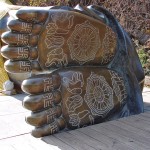
When I was very young, I was afraid the people I loved — mostly my old ladies — would die. And their deaths were important only as they impacted me (remember, I was a child). I would lose them. And be utterly lost without them.
Even then, product though I was of Methodist vacation Bible school and Sunday school, I found it hard to believe I would see anyone after death. They would be dead, and gone. Heaven seemed — even to a small child — an impossible daydream.
Now, an older lady myself, my attitude towards death is more wonder than terror. And I still dread the loss of those I love. But I have no idea what happens when we die. Is there a white light? A tunnel? Will my old ladies, my parents, my favourite dogs & cats, be there to me?

via wikicommons
I still don’t think so. Whether death is, literally, the end of light (curtains?) or something more…ongoing, I have no idea. And as a Buddhist, I find the idea of Nirvana almost as challenging to contemplate as Christian heaven. Christian heaven — with its congruence to Islam’s Jannah, where the dead will recognise each other, and live in paradise — is problematic for me, a parable designed to indicate that the dead go back to their eternal beginnings. Do not be frightened.
February 15th is the day when Buddhists around the world join in discussing just such thoughts. It’s the day celebrating the Buddha’s death, and his ascension from his physical body to Nirvana. The word Nirvana — unlike the warmer heaven (meaning: sky, home of God) or jannah (garden), means ‘to blow out,’ or ‘to extinguish.’ Not that precious Buddha nature (more on this in a moment), but the three ‘fires’ — passion, aversion, ignorance — that keep us so unhappy.

Meditations, visits to temples, and reflections on the impermanence of our lives and everyone we love are ways to honour Parinirvana Day. Another tradition is to read from the Nirvana Sutra, the Mahāyāna Mahāparinirvāṇa Sūtra. It’s a fascinating teaching, reminding us — and thus hoping to awaken us — to the knowledge that Buddhahood is innate within us. It’s the idea of Buddha nature that makes my understanding of Nirvana possible.

wikipedia
Non-Buddhists perhaps don’t know or remember that the Buddha was a Hindu. He grew up solidly within the cultural matrix of Saṃsāra — the cycle of rebirth. So Nirvana — freedom from that cycle of endless rebirth — is originally a Hindu concept, passed through the golden sieve of Buddhism. And it isn’t even so much about rebirth, as re-death, if that makes sense: the idea that with each birth comes another leaving, an ending. To achieve Nirvana means to be deathless — to beyond life & death. So it’s fitting that Parinirvana Day is immersed in contemplation of death, dying, and our mortality.
Buddhist Nirvana has always seemed…well, rational to me. I know that when I swim in the ocean, I’m part of it. Along w/ the other micro and macro inhabitants, I’m in/within the ocean. But I’m still me. And that seems imminently more logical a lens through which to view a possible after-death existence, even from a scientific viewpoint. Energy doesn’t cease to exist — it just transforms. Which leads me to be hopeful about death, the ultimate transformation of living matter. Our Buddha natures just go home.
I wish I thought I would actually see my blue-haired old ladies, and the ones with improbably gold and red ‘dos.’ I wish desperately that I could hug my mother & father. I just don’t think it’s going to happen. Instead, Buddhist teachings tell me, I can work right now to be a better person. Awaken to my own Buddha nature — that ember of light in each of us. And when I do? Then I can go home. In whatever shape that will take.

